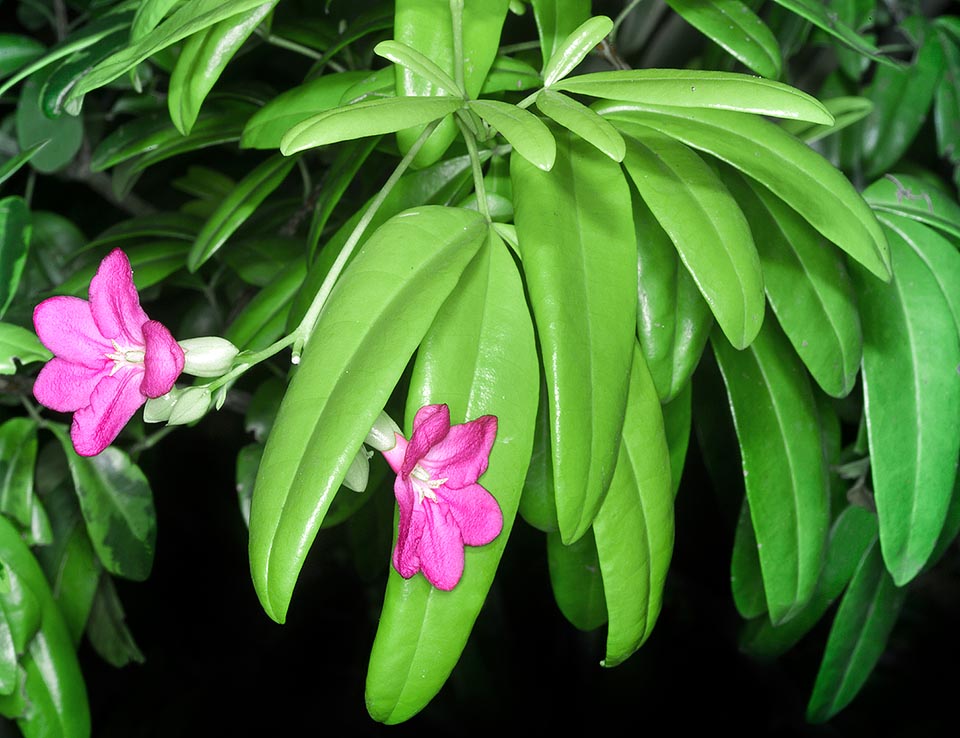Family : Rutaceae

Text © Pietro Puccio

English translation by Mario Beltramini
The species is native to Cuba and Haiti where it lives in the thickets at low and medium altitudes.
The genus was honoured to a not well indentified French man named J.F. Ravin; the specific name is the Latin adjective “spectabilis, e” = remarkable, admirable.
Common names: lemonia, limonia, pink ravenia (English); limão do mato, rosa ravena (Portuguese-Brazil); rosita (Spanish-Cuba).
The Ravenia spectabilis (Lindl.) Engl. (1874) is an evergreen unarmed bush, 1,5-4,5 m tall, with young pubescent branches. The leaves are opposite or subopposite, trifoliate, with obovate leaflets with obtuse apex, 3-8 cm long and 0,6-2 cm broad, coriaceous, of dark green colour and glossy, aromatic. Axillar and terminal racemose inflorescences, 5-8 cm long, with few hermaphroditic flowers, of about 2,5-3 cm of diameter, with 5 green sepals, of which the two outer ones ovate-elliptic, 1-1,5 cm long and 0,4-0,8 cm broad, and the three inner ones smaller, roundish and concave, of pale green colour. Pink to bright red imbutiform corolla with 1-1,5 cm long tube and 5 lobes, 4 of which united below, and one more isolated above, oblong with obtuse apex, thick and with rather granular surface, 1-1,5 cm long and 0,4-1 cm broad. Stamens merged to the tube two of which fertile with sessile anthers and three sterile with anthers reduced to thin white laminae that serve as roost for the pollinating insects.

Native to Cuba and Haiti Ravenia spectabilis is a 1,5-4,5 m tall shrub easy to cultivate in the tropics. Ornamental leaves and continuous blooming. Laboratory studies have evidenced the presence in the bark and leaves of alkaloids with antibacterial, antioxidant and cytotoxic activity of possible interest for official pharmacopoeia © G. Mazza
The flowers, rich of nectar, present the phenomenon of the proterandry (the male organs come to maturity before the female ones) that favours the cross-pollination. The fruits is formed by 1-5 monospermous follicles.
It reproduces by seed, in organic sandy loam, maintained humid at the temperature of 22-25 °C, by semi-woody cutting and air layering.
Species of easy cultivation with ornamental foliage and abundant and almost continuous blooming, utilizable as isolated specimen, in group and for borders in parks and gardens, even if small, in the tropical and subtropical climate regions, its cultivation may be tried in the temperate-warm ones, where temperatures of less than +5 °C are exceptional and short-lasting events. It requires a full sun exposition or slight shade and loose, draining soils, slightly acidic to neutral, maintained almost constantly humid. Cultivable also in pot, in draining loam rich of organic substance, for the decoration of open spaces, in the favourable climates, or verandahs and luminous inners spaces, with lowest winter temperatures preferably over the 16 °C. The waterings must be regular and abundant in summer, spaced in winter, in order to allow the substratum to partially dry up before giving water again, and monthly fertilizations, in spring summer, utilizing a hydrosoluble balanced product with microelements specific for pot plants. Laboratory studies have evidenced the presence in the bark and in the leaves of alkaloids with antibacterial, antioxidant and cytotoxic activity with opossible interest for the official pharmacopoeia.
→ To appreciate the biodiversity within RUTACEAE family please click here.
